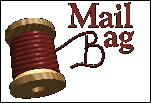QuestionsHome PagePressing MattersTypes of HemsGlossary of Terms |

The Mail BagAnswersThe answer side of this page will always be under construction! Do you have a sewing related question? Please drop me a note! Pressing Matters - ironing tips!It's the heat, not the weight of the iron that removes wrinkles. So there is never any need to press an iron down hard, whether it's set on dry or steam. Start ironing from the middle of each garment section and work outward, pressing extra material to the edges. Never iron in circular strokes! It will stretch out fabrics. Instead, iron lengthwise' carefully smooth out the ridges, or if steam is called for, level them with a shot of steam. To save time, first sort all your clothes according to the temperature settings they require. Then work from the coolest to the hottest, eliminating the need to wait for the iron to cool down between the temperature-setting changes. Always iron silks on the wrong side. This will help prevent an unattractive sheen. (from Family Circle 9-1-98) And for more ironing tips...check out Rowenta USA Return to topWhat are the differences in hems?Some practical tips...just added! (from Family Circle) A good general rule for derermining hem allowances is that the narrower and traighter the skirt, the deeper the hem should be; the more curved, the shallower. Also take into account the weight of the fabric, adjusting the hem according to how well it lies without sagging. A hem up to 3" is the usual allowance for straight skirts. and For an A-line or flare, 1 1/2" to 2" is fine.The hem finish you use depends on the fabric and style of the garment. Its weight, its raveling qualities and what kind of garment it is all play a part in deciding which hem to use. Probably the most common is the stitched and turned hem . It is used on light-weight, firmly woven fabrics that are not bulky and don't ravel easily. Trim it and fold a very narrow edge, stitch edge, turn the hem and use a hemming stitch or slip stitch to hold hem in place. For fabric that ravels you would probably want to use a hem finished with seam binding . Trim evenly and stay stitch the edge. Attach woven or bias seam binding. Don't put it on too tightly or it will pull and the hem will show on the right side of the garment. Slip stitch hem to garment. For very sheer or fine fabrics use a narrow hand-sewn hem (or cheat a little, roll and machine stitch) Turn under the edge 1/8" and stitch close to the edge, turn under again the same width and slip stitch hem edge to garment. In a true emergency, a glue stick, staples, or scotch tape work amazingly well! Just remember though, it's only a temporary fix - sooner or later you'll have to take up a needle and thread! Return to topGlossary of TermsIf you are going to follow directions (and after all, that is exactly what a pattern is!) you have to speak the language. There won't be room for all the sewing vocabulary that's out there, but maybe we can cover some of the more obscure (and perhaps even familiar) words! Basting Let's start with something easy! a long, loose, temporary stitch made by hand or machine. Use a contrasting thread for ease of removal later. Bodkin a blunt needle with an eye or a pin on the end used for threading tape, elastic or ribbon through beading or a casing. Catch-stitch a cross stitch used to hold raw edges in place securely. Couching an embroidery stitch in which a long, heavy double thread or cord is laid along a design and caught in place by another thread at equal intervals. Ease when one section of a seam is slightly fuller than the section to which it is joined, the fullness is distributed evenly without puckers or gathers and pressed so that the threads within the fabric are crowded closer together. This ease allows shaping for curved areas such as the bust in princess line, set-in sleeves, etc. Godet triangular or shaped piece of fabric that is set into skirts, curtains, etc., for added width at the bottom (picture those very full square dance skirts!) Miter diagonal joining of two pieces of fabric or lace that meet at a corner. Needle board a board covered with fine steel wires set vertically for use in pressing velvet and other nap or pile fabrics. (probably one of the more specialized tools of the trade!) Pickup line no, not something you hear in a bar (well not in this case anyway!) the center fold line of a dart or tuck. Pile fabric woven with a third set of yarns forming tufts or loops on the surface of the fabric. Loops may be cut or uncut. Velvet, velveteen, corduroy, terry cloth are examples. Rip every seamstress does it! To open a seam by pulling out or cutting the stitching. It's usually pretty obvious when you need to do that! That's it for the vocabulary lesson this month. I'd like to add a few words every month and build up the glossary gradually - check back every once in a while - see if I can stump you! Return to top |